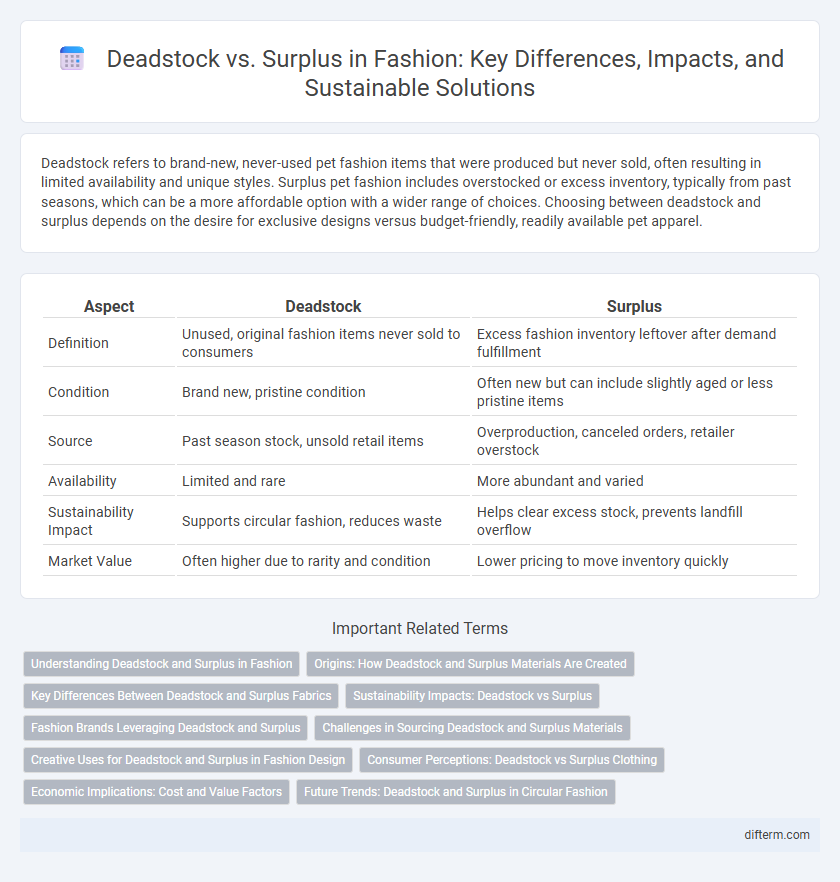Deadstock refers to brand-new, never-used pet fashion items that were produced but never sold, often resulting in limited availability and unique styles. Surplus pet fashion includes overstocked or excess inventory, typically from past seasons, which can be a more affordable option with a wider range of choices. Choosing between deadstock and surplus depends on the desire for exclusive designs versus budget-friendly, readily available pet apparel.
Table of Comparison
| Aspect | Deadstock | Surplus |
|---|---|---|
| Definition | Unused, original fashion items never sold to consumers | Excess fashion inventory leftover after demand fulfillment |
| Condition | Brand new, pristine condition | Often new but can include slightly aged or less pristine items |
| Source | Past season stock, unsold retail items | Overproduction, canceled orders, retailer overstock |
| Availability | Limited and rare | More abundant and varied |
| Sustainability Impact | Supports circular fashion, reduces waste | Helps clear excess stock, prevents landfill overflow |
| Market Value | Often higher due to rarity and condition | Lower pricing to move inventory quickly |
Understanding Deadstock and Surplus in Fashion
Deadstock refers to brand-new, unsold inventory that remains unused and in its original packaging, often sought after for its rarity and pristine condition. Surplus comprises excess products produced beyond current demand, which may include overproduced or outdated fashion items that brands attempt to clear through discounts. Understanding the distinctions between deadstock and surplus is essential for consumers and retailers aiming to navigate sustainable fashion and inventory management strategies.
Origins: How Deadstock and Surplus Materials Are Created
Deadstock materials originate from unsold inventory or leftover fabric produced during fashion manufacturing runs, often stored without being used for new collections. Surplus materials arise from overproduction, returns, or canceled orders, creating excess stock that exceeds market demand. Both deadstock and surplus result from inefficiencies in supply chain forecasting and production planning, contributing to significant material waste in the fashion industry.
Key Differences Between Deadstock and Surplus Fabrics
Deadstock fabrics refer to unused, leftover materials from previous production runs that remain in original condition, while surplus fabrics are excess materials produced beyond the intended quantity. Deadstock is often limited in quantity and highly valued for its exclusivity and sustainability, whereas surplus fabrics can be more abundant and vary in quality and type. Both fabric types offer eco-friendly options that reduce waste, but deadstock typically caters to niche markets seeking rare, vintage textiles.
Sustainability Impacts: Deadstock vs Surplus
Deadstock fashion utilizes unsold inventory that remains unused, reducing waste and lowering the demand for new textile production, which significantly cuts carbon emissions and resource depletion. Surplus inventory often results in overproduction, leading to increased landfill waste and environmental pollution when excess stock is discarded or destroyed. Opting for deadstock materials promotes circular fashion practices by repurposing existing resources, while surplus inventory management requires improved demand forecasting to mitigate sustainability impacts.
Fashion Brands Leveraging Deadstock and Surplus
Fashion brands leveraging deadstock and surplus materials reduce waste while enhancing sustainability by repurposing unused fabrics and unsold inventory into limited-edition collections. This strategy maximizes resource efficiency, cuts production costs, and appeals to eco-conscious consumers seeking unique, environmentally responsible fashion pieces. Embracing deadstock and surplus not only mitigates environmental impact but also strengthens brand identity through innovative, circular design practices.
Challenges in Sourcing Deadstock and Surplus Materials
Sourcing deadstock and surplus materials presents challenges such as limited availability and inconsistent quality, complicating supply chain reliability for fashion brands. These materials often come in unpredictable quantities and styles, making inventory planning difficult and potentially increasing production waste. Additionally, verifying the authenticity and sustainability of surplus fabrics requires rigorous sourcing protocols to maintain brand integrity and meet consumer expectations.
Creative Uses for Deadstock and Surplus in Fashion Design
Deadstock and surplus fabrics offer designers a sustainable source for creating limited-edition collections and unique, one-of-a-kind pieces that reduce waste and environmental impact. Innovative applications include patchwork garments, accessory production, and upcycled embellishments that enhance design value while promoting circular fashion. Leveraging these materials supports ethical practices and drives consumer interest in eco-conscious, artisanal fashion products.
Consumer Perceptions: Deadstock vs Surplus Clothing
Consumers often view deadstock clothing as exclusive and highly desirable due to its limited availability and vintage appeal, which can enhance brand prestige and perceived value. Surplus clothing, while generally more affordable and accessible, is sometimes perceived as lower quality or less trendy, affecting consumer willingness to pay premium prices. Understanding these perceptions helps brands strategically market deadstock as rare finds and surplus items as budget-friendly, sustainable options.
Economic Implications: Cost and Value Factors
Deadstock inventory, comprising unused and unsold items, often holds higher economic value due to its pristine condition and rarity, making it attractive for resale at premium prices. Surplus stock, typically excess production beyond market demand, tends to carry lower costs but also depreciates faster, posing challenges for inventory management and profit margins. Understanding these distinctions enables fashion businesses to optimize pricing strategies and inventory turnover, enhancing overall financial performance.
Future Trends: Deadstock and Surplus in Circular Fashion
Future trends in circular fashion emphasize the integration of deadstock and surplus materials to reduce waste and lower environmental impact. Brands increasingly leverage deadstock fabrics and surplus inventory to create limited-edition collections that appeal to eco-conscious consumers. This shift towards upcycling and responsible sourcing fosters innovation and sustainability within the fashion industry's supply chain.
deadstock vs surplus Infographic

 difterm.com
difterm.com